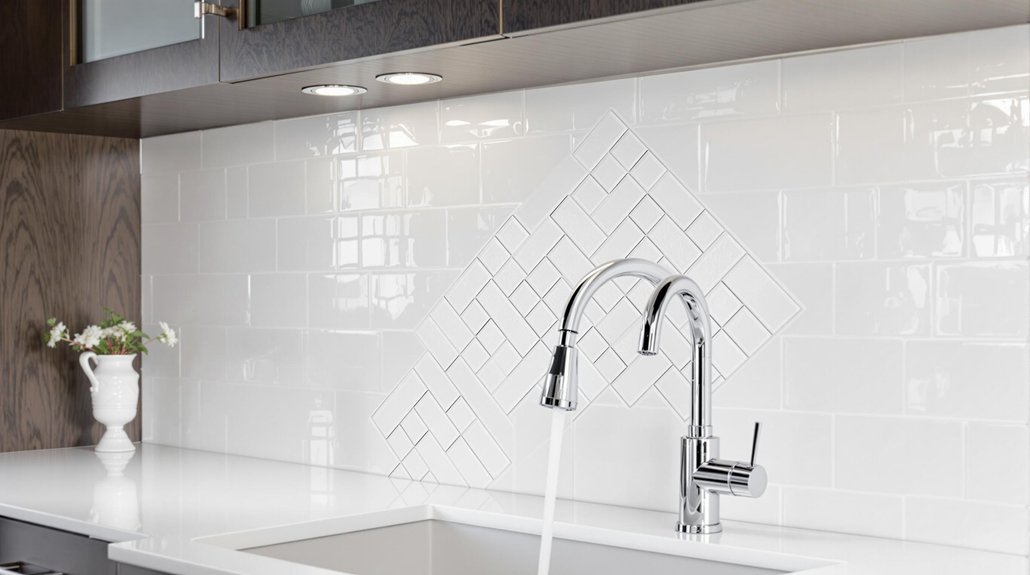
16 White Kitchen Tile Backsplash Ideas That Add Subtle Texture
White kitchen tile backsplashes gain refined texture through classic squares, metro tiles, and herringbone or chevron arrangements. Subtle depth is created with hexagonal shapes, basketweave textures, Zellige tiles, and lightly embossed patterns. Contrasting grout, hand-painted motifs, or marble add visual intrigue, while mosaic accents and rustic wood complement crisp white tones. Monochrome schemes and layered layouts offer tailored sophistication. Each design detail enhances tactile appeal and timeless elegance; a curated selection reveals many striking interpretations ahead.
Key Takeaways
- Incorporate subtly patterned or lightly embossed white tiles to create visual depth while maintaining a clean, neutral aesthetic.
- Use herringbone or chevron layouts with white tiles to add movement and refined texture without overwhelming the space.
- Opt for handcrafted Zellige or basketweave tiles to provide tactile interest and artisanal character to a white kitchen backsplash.
- Combine hexagonal or matchstick-shaped white tiles with contrasting grout for understated geometric texture and definition.
- Mix classic white square or metro tiles with textured mosaics or decorative borders to introduce subtle variation and sophistication.
Classic White Square Tiles
Classic white square tiles embody timeless versatility, offering a clean backdrop that seamlessly integrates with contemporary, traditional, or changeover kitchen designs. Their understated elegance is prized for achieving a timeless look, serving as the foundation of a refined white tile backsplash.
Design professionals recommend these tiles for their cost-effective installation, allowing significant aesthetic impact while maintaining budget efficiency. For enhanced visual intrigue, black grout can be paired with classic white square tiles, establishing a striking contrast and defining geometric precision.
An alternative installation, such as a diamond layout, introduces a dynamic twist that modernizes the conventional grid. Exemplars like Damask Blanco underscore the crisp, pristine qualities expected of a premium white tile backsplash, ensuring enduring appeal in diverse kitchen environments.
Traditional-Style Metro Tiles
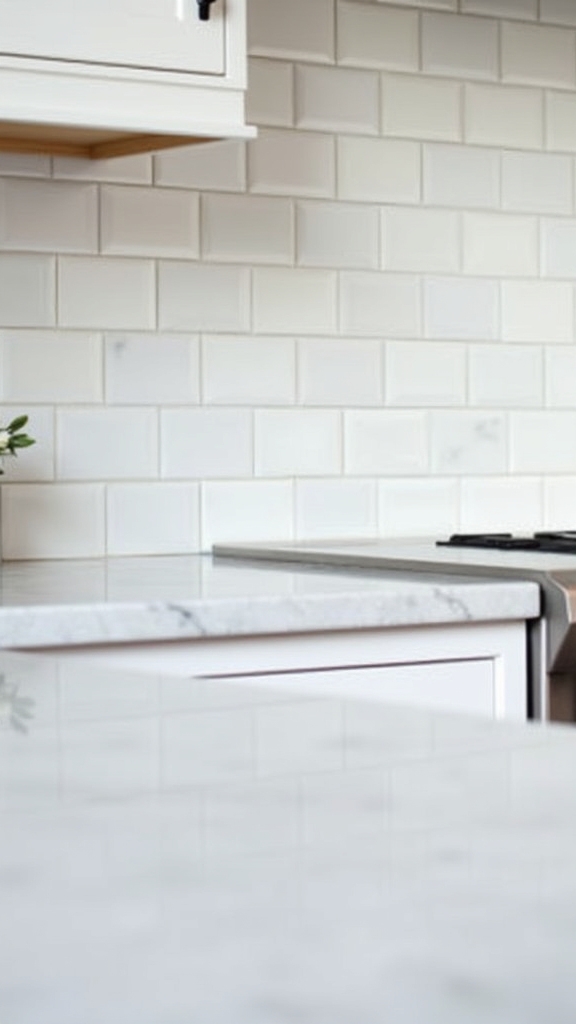
Building upon the enduring appeal of white square tiles, traditional-style metro tiles introduce a sophisticated layer of design flexibility to kitchen backsplashes.
These tiles, characterized by their classic white finish and rectilinear form, offer versatility that suits a broad spectrum of kitchen aesthetics, from refined farmhouse to adaptive spaces.
Commonly arranged in brick bond or herringbone patterns, traditional-style metro tiles enhance visual interest while maintaining a subtle texture that prevents the backdrop from appearing flat or sterile.
Traditional-style metro tiles arranged in brick bond or herringbone patterns add depth and subtle texture to kitchen backsplashes.
Incorporating moulded border tiles further enhances the look, imparting a sense of craftsmanship and elegance.
The Dorset Blanco tile exemplifies this approach, reflecting light and amplifying spatial perception.
The result is a harmonious blend of vintage charm and contemporary refinement, ideal for timeless kitchen design.
Modern Metro Tiles
Clean lines and geometric precision define the appeal of modern metro tiles in contemporary kitchen design. Characterized by their elongated rectangular shape, modern metro tiles establish a sleek, unfussy foundation for a white backsplash that prioritizes refined simplicity.
Designers frequently select layouts such as stacked or offset patterns, which allow for tailored visual rhythm and subtle texture within the space. The versatility of finishes and tones guarantees these tiles seamlessly adapt to varied interior palettes, reinforcing a clean and minimalist appearance.
A recommended choice, the Emilia Blanco tile, exemplifies this streamlined aesthetic, offering understated sophistication without overwhelming the kitchen’s overall ambiance.
Additionally, modern metro tiles deliver practicality—easy to clean and maintain—making them especially suitable for high-traffic cooking environments that demand both style and function.
White Tiles With Black Grout
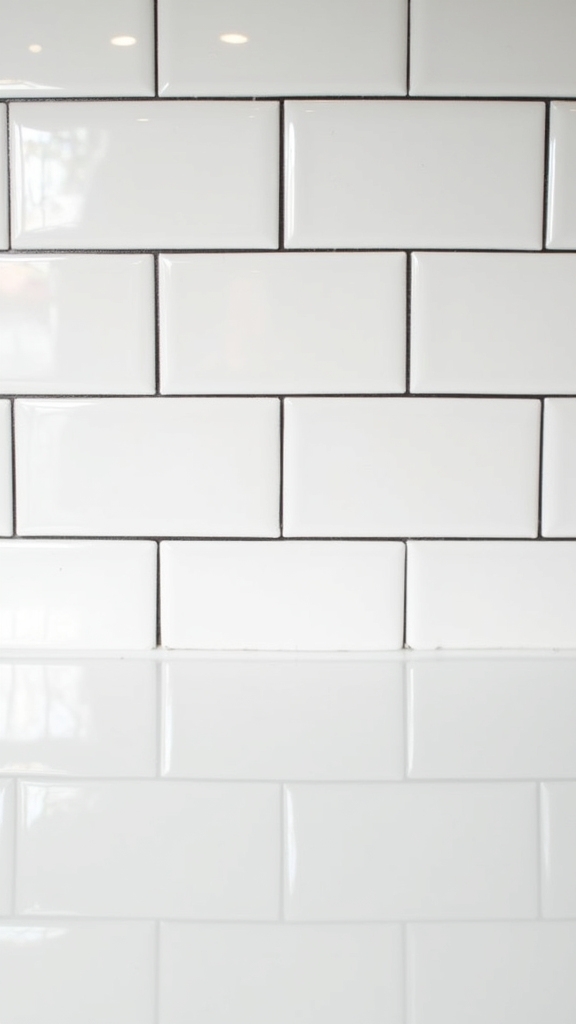
White tiles paired with black grout deliver a visually commanding contrast, sharply delineating each tile and accentuating geometric precision.
This high-definition approach amplifies the impact of pattern layouts—such as subway or herringbone—by drawing the eye to intricate lines and shapes.
The result is a backsplash that seamlessly blends modern sophistication with timeless monochrome appeal.
Striking Contrast and Definition
While many kitchen designs seek subtlety, the pairing of white tiles with black grout delivers a deliberate, graphic impact that instantly defines the backsplash area.
This classic black-and-white combination enhances visual appeal through striking contrast, ensuring the backsplash stands out as a focal point. The black grout outlines each white tile, emphasizing the geometric precision of subway or rectangular formats and drawing the eye along the crisp, linear arrangement.
Additionally, this juxtaposition highlights the unique surface textures and shapes of tiles such as the Asha White, adding both depth and dimension.
The approach is both elegant and functional, creating a visually cohesive backdrop that marries timeless aesthetic with modern sensibilities, ensuring the kitchen remains sophisticated, current, and visually compelling for years to come.
Pattern Emphasis Techniques
Drawing the eye to intricate arrangements, the use of black grout with white kitchen tiles serves as a dynamic technique for accentuating pattern and structure.
By employing black grout, the outlines of each white kitchen backsplash tile become sharply defined, amplifying the geometric interplay in both classic and contemporary tile patterns. This high-contrast approach is especially effective with configurations such as herringbone, chevron, or traditional subway layouts, where the grout delineates each individual tile’s form and orientation.
The visual rhythm created by the juxtaposition of stark white tiles and bold black lines introduces depth and dimensionality, transforming a simple surface into a statement feature.
Additionally, black grout accommodates the integration of mixed tile shapes and sizes, maintaining cohesive styling across varied design elements.
Modern Classic Appeal
Timeless sophistication defines the black-and-white palette achieved by pairing crisp ceramic tiles with deep charcoal grout. This classic combination of white tiles and black grout imparts a modern classic appeal, seamlessly bridging the gap between contemporary minimalism and traditional elegance.
The high-contrast grout lines sharply delineate each tile, accentuating geometric arrangements—particularly with subway tile installations. This visual emphasis not only enhances architectural interest but also guarantees that the backsplash becomes a focal design element within the kitchen space.
Beyond aesthetics, black grout offers practical benefits by camouflaging stains and maintaining a pristine appearance in busy households. Versatile and enduring, this palette complements a wide range of cabinetry finishes and hardware styles, ensuring the kitchen retains a fresh yet timeless ambiance for years.
Hexagonal Tiles
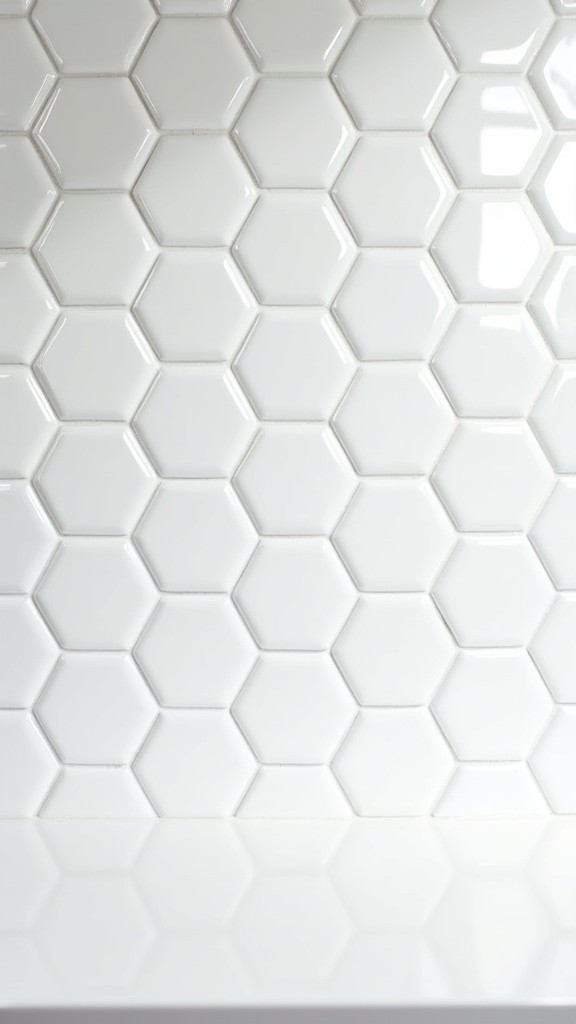
Geometry takes center stage with hexagonal tiles, introducing a distinct pattern that instantly enhances the visual complexity of a white kitchen backsplash. The six-sided design of hexagonal tiles delivers rhythmic repetition and a subtle interplay of shadow and light, resulting in nuanced texture across the kitchen backsplash tile surface.
Their angular form adapts seamlessly to both linear and irregular spaces, making them particularly effective for unconventional kitchen layouts. For added dimension, designers often select contrasting grout shades, accentuating each tile’s outline and amplifying the geometric motif.
Incorporating mixed textures or a hint of color within select hexagonal tiles can create a dynamic focal point without overwhelming the crisp, clean aesthetic. Options like Ava Blanco Plain highlight the versatility and timeless sophistication of hexagonal tiles in contemporary kitchen design.
Subtly Patterned White Tiles
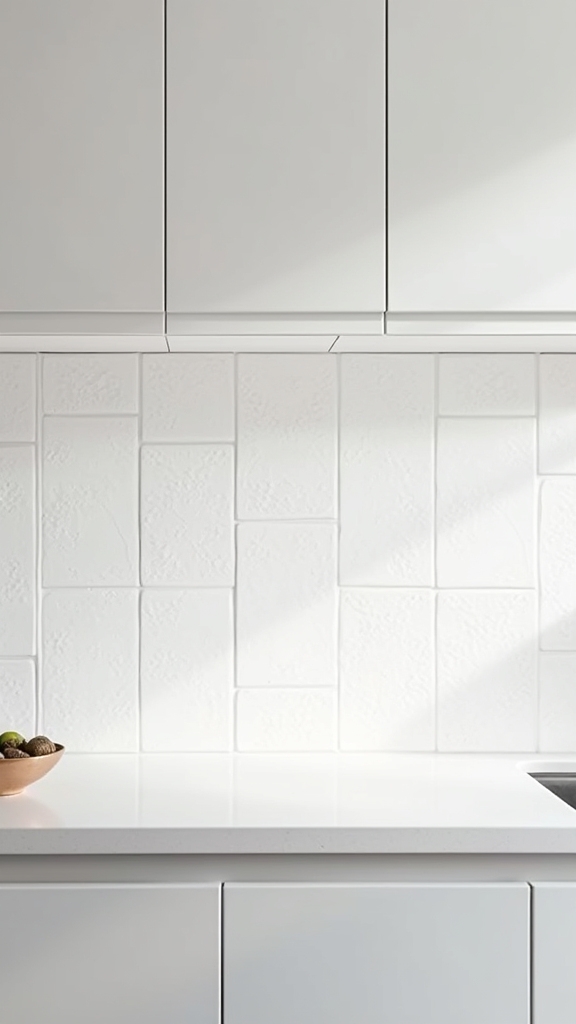
While bold geometric shapes like hexagonal tiles establish striking visual rhythm, subtly patterned white tiles offer a more understated approach to elevating kitchen backsplashes.
These tiles introduce gentle dimension and depth, enhancing the appeal of white kitchen backsplash ideas without disrupting a neutral palette.
Texture is achieved through refined motifs—think herringbone, petite geometrics, or barely-there embossing—that enrich the kitchen’s atmosphere with sophistication and restraint.
Refined motifs like herringbone or subtle embossing bring sophisticated texture and understated elegance to any kitchen backsplash.
Subtly patterned white tiles work across a spectrum of kitchen styles, seamlessly uniting classic elegance with fresh, modern sensibilities.
- Visual Depth: Subtle patterns, such as those found in Canyon Mosaic, add layers of visual interest while preserving cohesion.
- Timeless Versatility: These tiles complement both traditional and contemporary designs.
- Tactile Appeal: Fine texture creates a sophisticated tactile experience.
- Personalization: Enables nuanced expression within a unified aesthetic.
Zellige Style Tiles
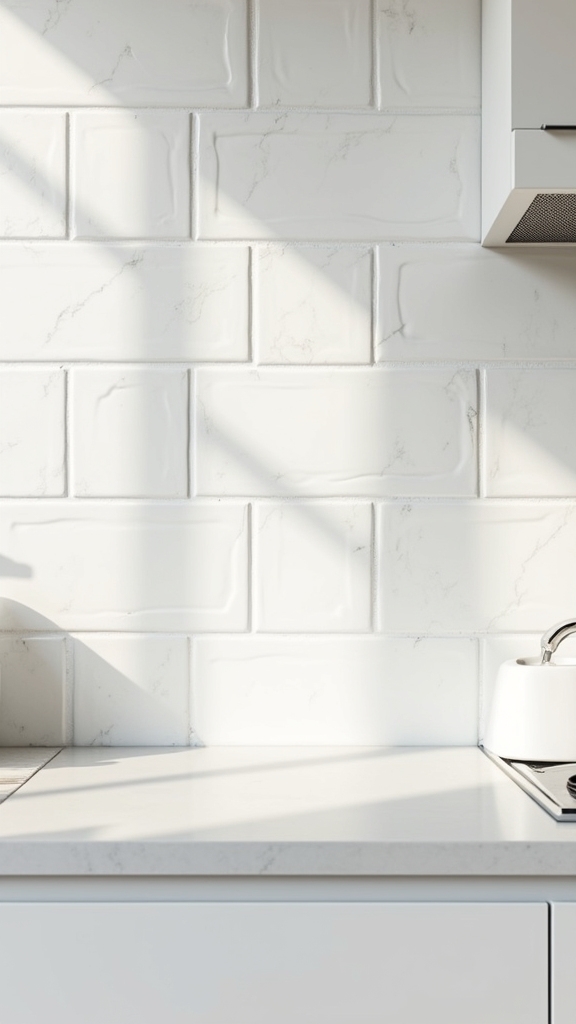
Embodying centuries-old craftsmanship, Zellige style tiles introduce tactile richness and luminous depth to kitchen backsplashes through their uneven surfaces and artisanal imperfections.
Each handcrafted tile is distinguished by a subtly irregular texture, allowing light to interact dynamically across the backsplash. These tiles often display nuanced variations in color and finish, contributing to an aesthetic of sophisticated individuality and artisanal charm.
Closely set, Zellige style tiles amplify their visual impact, creating an intricate mosaic that draws the eye and anchors the kitchen’s design narrative. Their rustic yet refined character complements both traditional and contemporary settings, seamlessly integrating with a range of cabinetry and countertop materials.
The result is a bespoke, one-of-a-kind installation where texture and craftsmanship are celebrated as focal elements in the kitchen.
Decorative Tile Layout
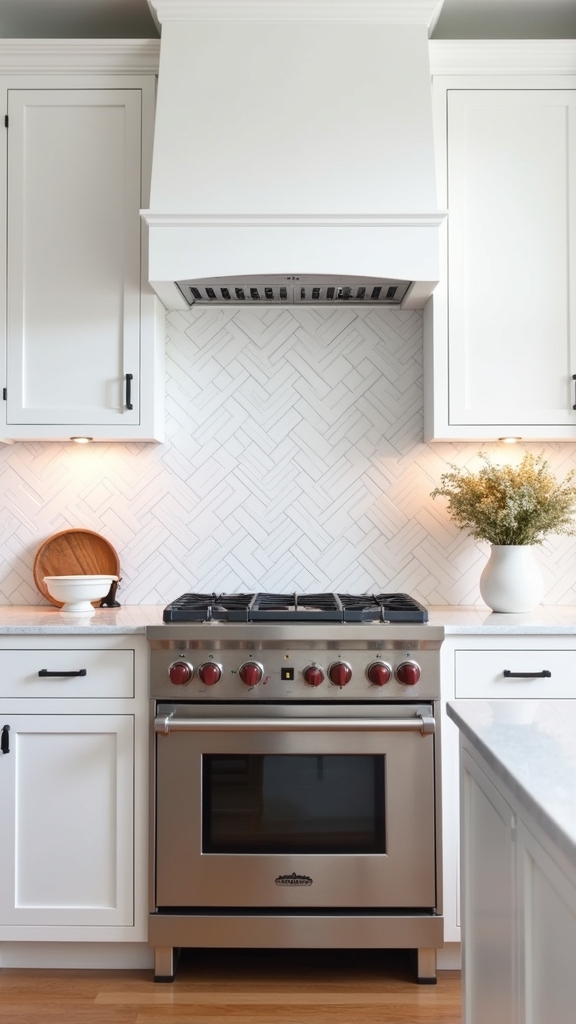
Decorative tile layout transforms the white kitchen backsplash through creative panel arrangements, strategic mixing of borders and mosaics, and masterful use of contrasting techniques.
By integrating panels and borders of uniform tiles with intricate mosaic accents, designers achieve both cohesion and dynamic focal points.
Contrasts in layout and texture enhance the overall composition, introducing depth and refined visual hierarchy.
Creative Panel Arrangements
Frequently, the impact of a white kitchen backsplash is defined by the ingenuity of its tile arrangement. Creative panel arrangements enable designers to transform standard backsplash tiles into dynamic visual statements.
By utilizing variations in shape, size, and pattern, a kitchen can exude both subtlety and sophistication. Implementing marble mosaic tiles or mixing geometric profiles introduces depth, while maintaining a monochromatic palette preserves cohesion.
The following approaches are exemplary in achieving nuanced texture and visual intrigue:
- Stacked or staggered rectangular tiles for streamlined or rhythmic effects.
- Diagonal herringbone and chevron layouts to evoke movement and modernity.
- Panels of marble mosaic tiles interspersed with classic field tiles for refined contrast.
- Alternating tile sizes within a panel for bespoke, dimensional surface articulation.
Mixing Borders and Mosaics
While a monochromatic scheme establishes a timeless foundation, the integration of borders and mosaic inserts enhances a white kitchen backsplash into a sophisticated focal feature. Employing decorative tile layouts with borders allows for precise delineation of kitchen zones, lending a sense of order and cohesion. Mosaics, when juxtaposed against expansive white tiles, generate compelling texture and subtle visual intrigue. By intermixing tile shapes—such as combining classic squares with slender mosaic strips—a dynamic yet harmonious composition emerges. These strategies not only amplify tactile depth but also allow for personalized expression within a restrained palette. The following table illustrates approaches to mixing borders and mosaics for added texture:
| Technique | Visual Impact |
|---|---|
| Mosaic accent strips | Targeted texture |
| Framed border panels | Defined zones |
| Mixed tile sizes | Dynamic rhythm |
| Patterned mosaic insets | Artistic emphasis |
| Coordinated grout choices | Enhanced cohesion |
Contrasting Layout Techniques
Beyond the interplay of borders and mosaics, the arrangement of white tiles themselves becomes a tool for introducing contrast and sophistication.
Contrasting layout techniques, such as the herringbone pattern or decorative layouts, redefine a backsplash’s impact. Strategic placement goes beyond mere utility, offering visual intrigue through geometric precision and dynamic orientation.
By manipulating tile direction, scale, and shape, designers craft a refined canvas that merges subtlety with architectural interest.
- Herringbone Pattern: Diagonal placement of rectangular tiles infuses kinetic energy, transforming the backsplash into a statement feature.
- Chevron Layout: Angled ends create seamless arrows, delivering continuous motion and distinctive symmetry.
- Mixed Tile Sizes: Combining large and small tiles within a monochromatic palette yields nuanced visual depth.
- Mosaic Accents: Decorative layouts introduce intricate contrast, punctuating expanses of white with tactile, artistic flair.
Matchstick Tiles
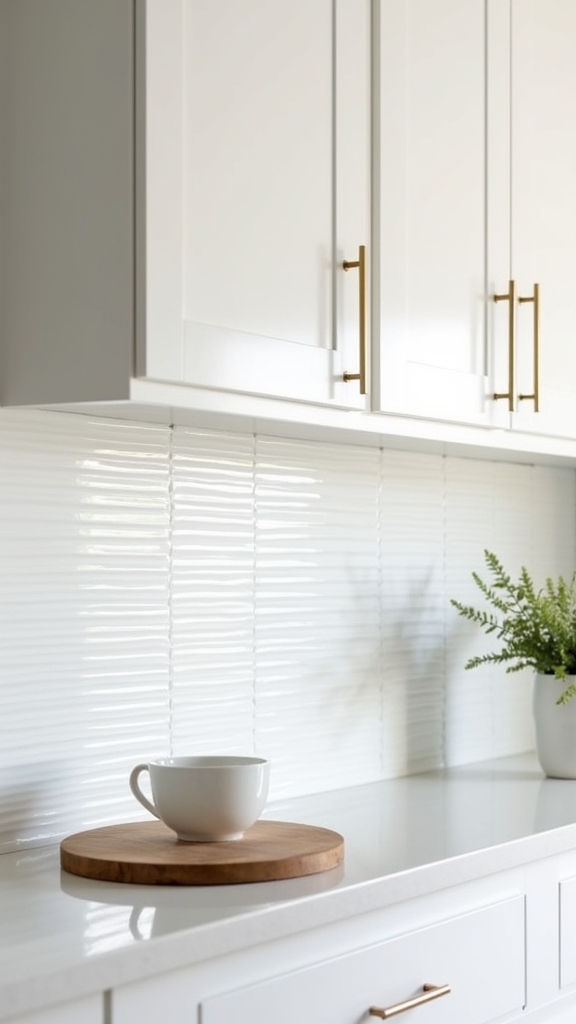
Among contemporary backsplash options, matchstick tiles stand out for their long, narrow porcelain form inspired by Japanese design principles. These tiles offer an enhanced sense of sophistication, making them a preferred choice in modern kitchens seeking subtle texture and minimalist elegance. The elongated profile of matchstick tiles allows for impactful layouts, whether installed horizontally for a calming linear effect or vertically for a sense of height. Their refined appearance creates visually cohesive backsplashes that enhance spatial perception without overwhelming the kitchen’s aesthetic.
Matchstick tiles’ versatility extends to color and material pairings, enabling designers to craft custom patterns and nuanced textures. The following table highlights key benefits and characteristics:
| Feature | Description |
|---|---|
| Shape | Long, narrow porcelain form |
| Design Origin | Japanese minimalist inspiration |
| Layout Versatility | Horizontal or vertical installation |
| Aesthetic Impact | Subtle, refined, modern kitchens |
| Texture Possibilities | Unique patterns through color/material mix |
Marble Tiles
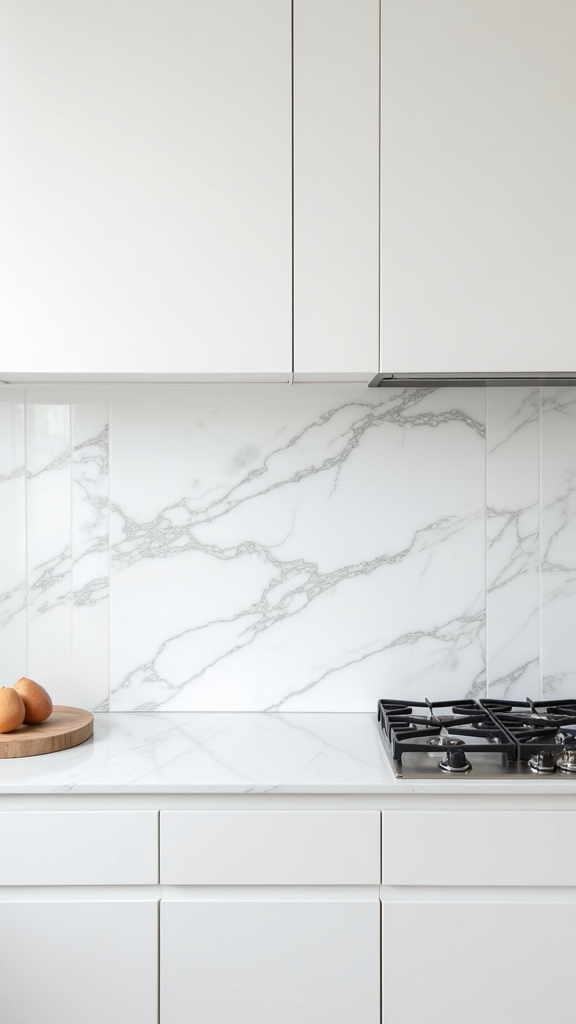
Few materials rival the refined elegance of marble tiles for a white kitchen backsplash.
Marble tiles introduce a sophisticated, cool-toned aesthetic that complements both classic and contemporary kitchens. Carrara marble, in particular, stands out for its timeless white background and distinct gray veining, enhancing visual texture without overpowering the space. The versatility of marble allows integration with white subway tiles, creating a seamless shift or defined accent within kitchen backsplashes. To further enhance your kitchen, mixing matte and glossy finishes on cabinets can create dynamic visual interplay.
- Versatile Formats: Marble tiles are available in large format slabs or intricate mosaics, catering to varied design preferences.
- Durability: Their natural strength guarantees resilience against heat and moisture common in culinary environments.
- Unique Patterning: Each marble tile features one-of-a-kind veining, adding bespoke character.
- Maintenance: Regular sealing is essential to protect marble from stains and preserve its pristine appearance.
White Herringbone Tile Patterns
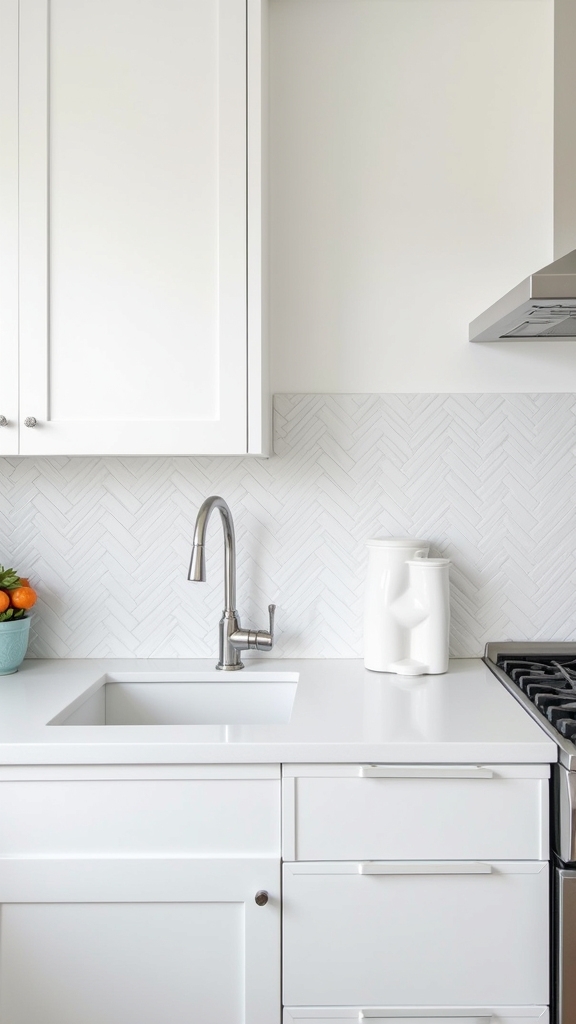
White herringbone tile patterns offer an enhanced aesthetic, balancing classic elegance with a contemporary edge through their distinctive zigzag arrangement.
The dynamic diagonal layout not only introduces refined texture and movement but also visually expands compact kitchen spaces.
When paired with subtle grout contrasts, this approach amplifies both the architectural interest and enduring versatility of the backsplash design.
Classic Herringbone Elegance
When precision and timeless appeal are desired, the classic herringbone pattern delivers a sophisticated visual impact in kitchen design.
The Herringbone Tile arrangement utilizes rectangular tiles—most often the 3×6-inch subway format—set in a distinct zigzag pattern that introduces subtle movement and texture. Especially when paired with white cabinets, this pattern amplifies a light and airy ambiance while imparting architectural interest.
Soft gray grout lines define each tile, providing gentle contrast and dimensionality without dominating the palette. This classic configuration offers seamless adaptability for both modern and traditional kitchens.
- Enhances visual texture without sacrificing a clean, cohesive aesthetic.
- Soft gray grout emphasizes pattern while maintaining elegance.
- Complements white cabinets for a unified, light and airy effect.
- Versatile enough for transitional, contemporary, or classic kitchen styles.
Modern Diagonal Layouts
Elevating kitchen design with striking geometry, modern diagonal herringbone tile layouts introduce a sense of movement and contemporary flair to the backsplash.
The herringbone pattern, arranged on the diagonal, creates a visually dynamic surface that draws the eye upward, amplifying both height and sophistication in a modern farmhouse kitchen.
White tiles maintain a light, airy ambiance, while the use of soft gray grout imparts subtle contrast—accentuating the intricate configuration without overpowering the space.
This design approach not only provides tactile interest and depth but also harmonizes effortlessly with white cabinetry and countertops, offering versatility across contemporary and traditional aesthetics.
As a backsplash solution, diagonal herringbone patterns serve as a refined focal point, transforming functional surfaces into cohesive, visually enchanting elements within the kitchen environment.
White Brick Backsplash Texture
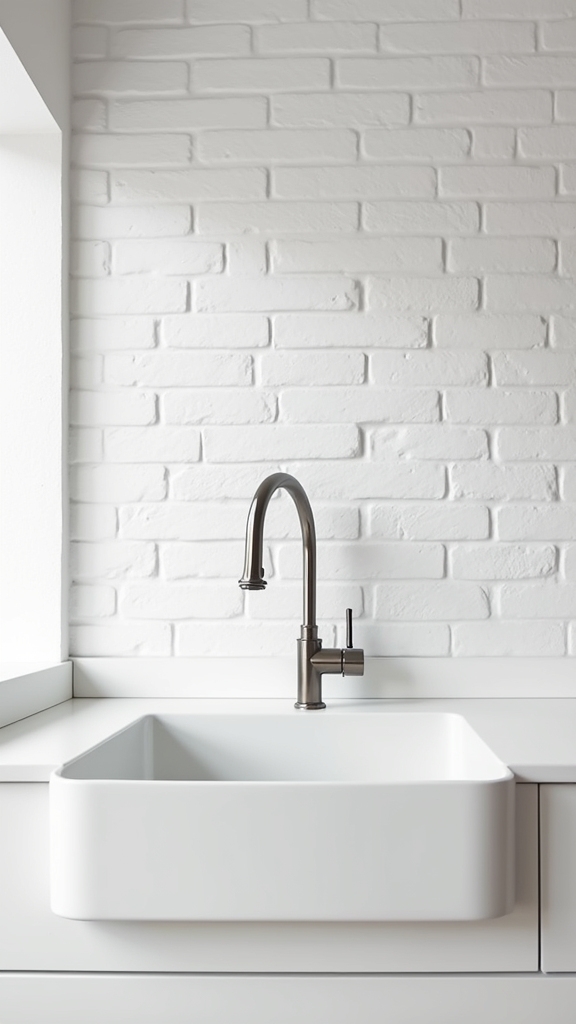
A textured brick backsplash introduces architectural depth and tactile interest to kitchen environments, serving as both a functional and aesthetic focal point.
The nuanced qualities of white brick—ranging from lustrous to matte finishes—offer designers a versatile palette for infusing subtle texture into the space. Distinctive glazes such as Lewis Range, Olympic, and White Mountains each contribute unique surface qualities, enhancing both light diffusion and visual layering.
Design professionals leverage these materials to seamlessly connect cabinetry, countertops, and hardware, maintaining a cohesive and airy atmosphere.
- Varied Finishes: Lewis Range’s glossy surface reflects light, Olympic’s crackled glaze imparts rusticity, and White Mountains’ matte finish offers soft, organic appeal.
- Pattern Versatility: Herringbone, stacked, and half-offset layouts maximize visual intrigue.
- Harmonizing Elements: White brick backsplashes unify disparate kitchen features.
- Textural Contrast: Adds dimension without overwhelming the design.
Hand-Painted White Tiles
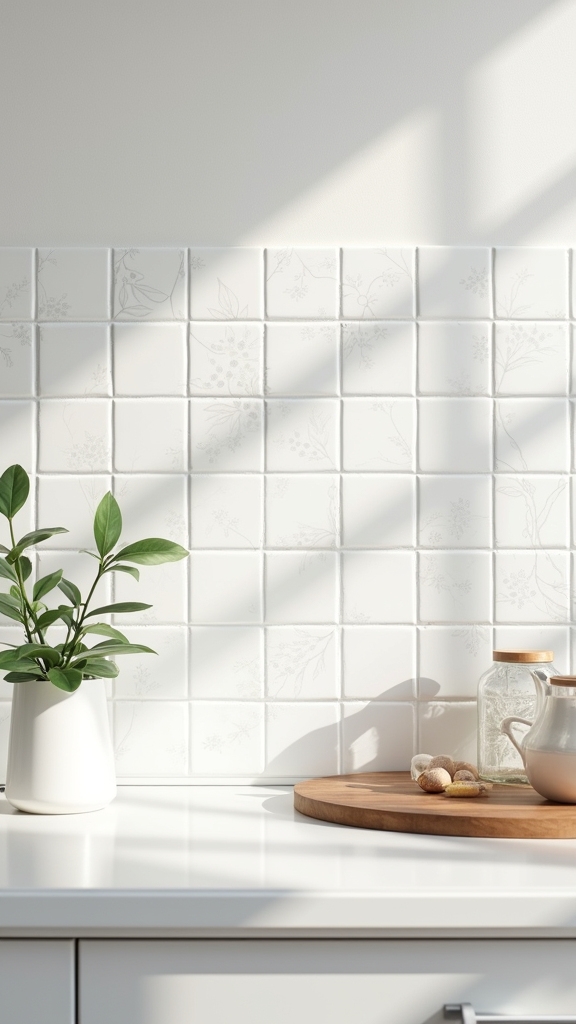
Hand-painted white tiles introduce the distinctive allure of artisan craftsmanship, where each piece reflects subtle individuality and tactile nuance.
Intricate, understated patterns impart a refined sense of depth, creating visual interest without overpowering the monochrome palette.
This timeless approach harmonizes bespoke detailing with enduring elegance, positioning the backsplash as both artful feature and functional surface.
Unique Artisan Craftsmanship
Artisan craftsmanship finds expressive form in white hand-painted tiles, where subtle imperfections and intricate patterns infuse kitchen backsplashes with visual depth and individuality.
Each artisan tile serves as a proof of unique craftsmanship, transforming the backsplash into a curated canvas that celebrates bespoke artistry. Expertly rendered by skilled hands, these tiles raise simple white surfaces through minute brushwork and nuanced texture, all while maintaining a cohesive, neutral palette.
The choice of hand-painted tiles enables homeowners to integrate one-of-a-kind detailing that harmonizes with both contemporary and classic kitchen designs.
- Customizable designs allow for personalized motifs and tailored color accents.
- Subtle irregularities in artisan tiles contribute to a sense of authenticity and tactile interest.
- Durable materials such as ceramic and porcelain guarantee longevity in high-traffic areas.
- Hand-painted tiles establish a timeless focal point, highlighting unique craftsmanship.
Subtle Patterned Detailing
Building upon the narrative of bespoke craftsmanship, subtle patterned detailing emerges as a sophisticated approach to white kitchen backsplashes. Hand-painted tiles, each bearing unique brushwork and nuanced glazing, introduce a refined textured surface that enhances visual depth and interplay with ambient light.
This meticulous artistry offers an artistic element, infusing kitchen environments with individuality and quiet distinction. The customization inherent in hand-painted tiles enables alignment with a spectrum of design themes, from rustic charm to understated contemporary elegance, ensuring the backsplash remains both versatile and distinctive.
Timeless Monochrome Appeal
Although the color palette remains restrained, the use of hand-painted white tiles introduces nuanced texture and subtle patterning that invigorate the monochrome backsplash.
The inherent individuality in each tile—created through artisanal craftsmanship—ensures a unique installation, where no two tiles are identical.
This subtle texture not only enhances visual interest but also maintains a polished, timeless appeal that integrates seamlessly with both traditional and contemporary kitchen aesthetics.
The sophisticated interplay of delicately painted motifs and refined finishes establishes a dynamic yet understated focal point, improving the space’s ambiance without diverging from a cohesive white scheme.
- Hand-painted white tiles lend character through personalized craftsmanship and unique surface variations.
- Subtle texture and gentle patterning enhance the backsplash’s depth, resisting visual monotony.
- Their timeless appeal offers versatile compatibility with multiple design styles.
- The understated artistry serves as an elegant, enduring focal point.
White Tiles With Rustic Wood Accents
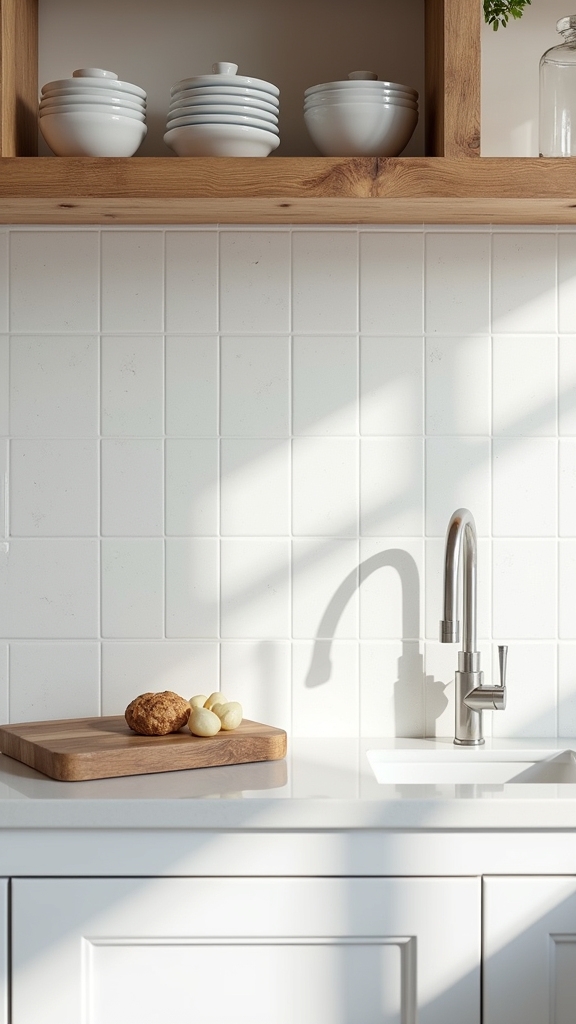
When paired thoughtfully, white kitchen tiles and rustic wood accents establish a balanced interplay between contemporary refinement and timeworn charm.
The juxtaposition of sleek, glossy white tiles with the rustic texture of reclaimed or distressed wood introduces compelling visual depth and tactile variation.
Sleek white tiles meet rustic reclaimed wood, creating striking visual contrast and inviting texture in any kitchen setting.
Shelving or cabinetry crafted from weathered wood enhances the white tile backsplash, infusing the kitchen with a warm atmosphere that feels both curated and inviting.
This harmonious blend of materials not only enhances aesthetic appeal but also supports sustainable design through the use of repurposed elements.
The crispness of white tiles acts as a clean backdrop, allowing the organic grain and patina of the wood to stand out, fostering a space where modern sensibilities and rustic warmth coexist effortlessly.
Basketweave and Chevron White Tile Designs
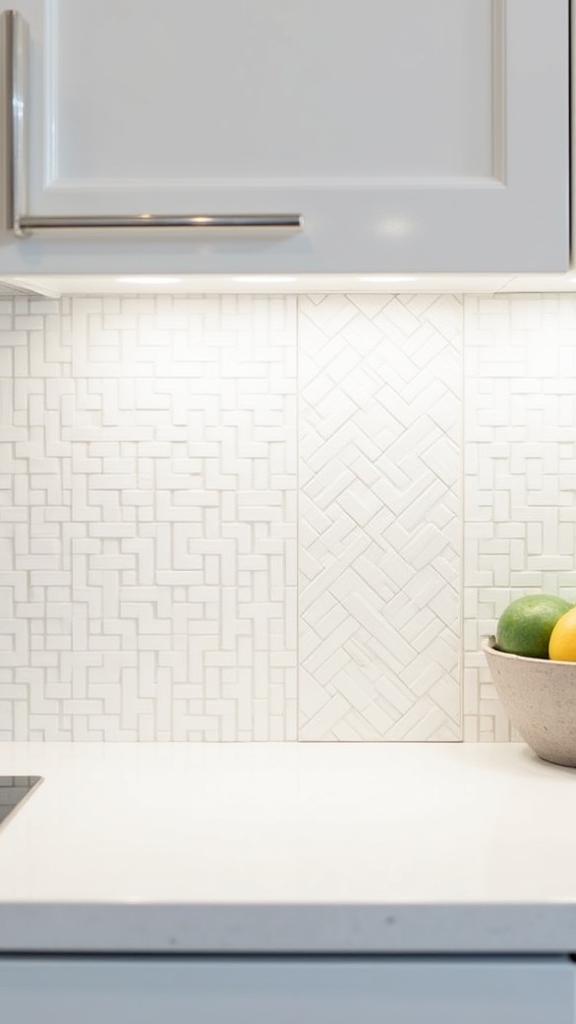
Among the most visually engaging options for a white kitchen backsplash, basketweave and chevron tile designs deliver both dimension and sophistication.
These patterns offer a refined approach to introducing texture, balancing subtlety with visual intrigue. Expert designers value their versatility, as both basketweave and chevron harmonize with a range of kitchen aesthetics while maintaining a crisp white palette.
Strategic grout color selection and finish choice further customize the effect.
- Basketweave Texture: Alternating rectangular and square tiles evoke a woven look, creating tactile depth and intricate shadow play.
- Chevron Pattern: Angled tiles form striking V-shapes, infusing energy and a sense of movement without disrupting the kitchen’s serenity.
- Finish Flexibility: Glossy or matte surfaces adjust light reflection, impacting ambiance and perceived texture.
- Custom Grout: Contrasting or matching grout enhances or softens the overall design impact.
Mosaic Accent Panels in White
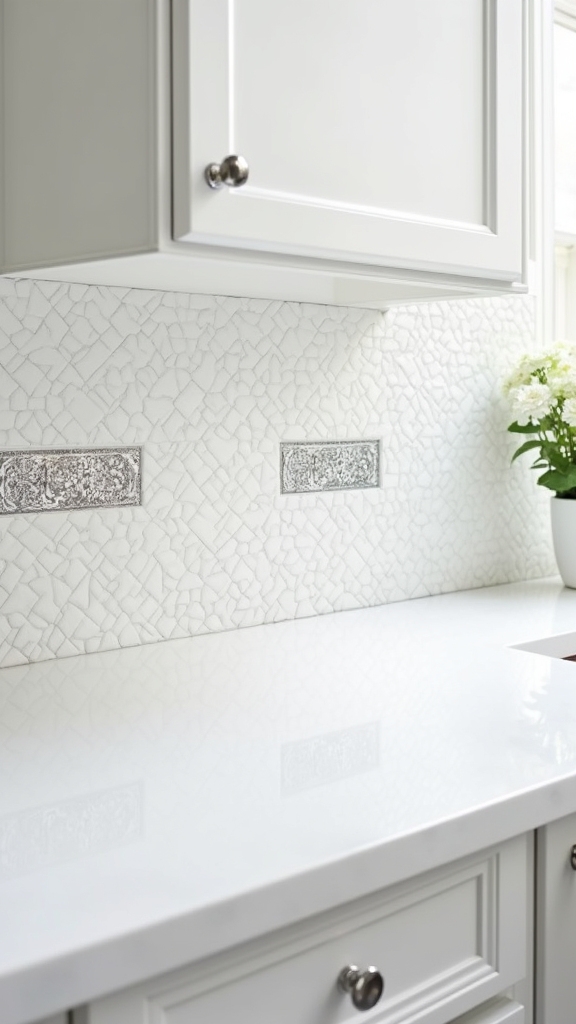
Through the strategic use of mosaic accent panels in white, a kitchen backsplash gains nuanced visual depth and layered texture without overwhelming the space.
Mosaic accent panels introduce intricate patterns and tactile surfaces that enrich a textured backsplash, while maintaining the understated elegance of an all-white palette.
White mosaic tiles, arranged in sophisticated layouts such as herringbone or chevron, offer a dynamic interplay of shapes and lines. Glossy finishes on these tiles amplify natural and artificial light, enhancing spatial perception in compact kitchens.
Designers often utilize mosaic accent panels as focal points—positioned behind cooking ranges or sinks—to subtly draw attention and personalize the environment.
Incorporating open shelves around the sink window can enhance both functionality and design, creating a modern look that complements the mosaic backsplash.
This approach enables creative expression and visual continuity, ensuring the backsplash remains cohesive while offering detail and visual intrigue.
Frequently Asked Questions
Are White Tile Backsplashes Easy to Clean and Maintain?
The ease of cleaning white tile backsplashes depends on grout lines, glaze finish, and durability factors. Cleaning tips include regular wiping with pH-neutral maintenance products, which prevent staining and discoloration, thereby preserving the backsplash’s cohesive styling and visual emphasis.
Can White Kitchen Tiles Withstand High Heat Behind a Stove?
The inquiry addresses whether white kitchen tiles exhibit adequate heat resistance and tile durability behind a stove. Properly installed ceramic or porcelain tiles offer high heat resistance, promoting kitchen safety and preserving aesthetic integrity in high-temperature environments.
What Lighting Best Highlights Textured White Backsplash Tiles?
Ideal illumination for textured white backsplash tiles combines ambient lighting for overall brightness, accent lighting such as under-cabinet LEDs to emphasize texture, and natural light to enhance depth. This layered approach guarantees cohesive styling and highlights visual intricacies expertly.
How Do I Prevent White Grout From Discoloring Over Time?
To prevent white grout from discoloring over time, one should employ advanced grout sealing techniques, adhere to consistent grout maintenance tips, and utilize proven stain prevention methods, ensuring ideal visual cohesion and lasting vibrancy within the kitchen environment.
Are White Tile Backsplashes Suitable for Small Kitchens?
White tile backsplashes are highly suitable for small kitchen design, offering visual expansion and brightness. Selecting larger tile size options reduces grout lines, while strategic color coordination tips—such as pairing with light cabinetry—enhances cohesive styling and maximizes perceived space.
Conclusion
A white kitchen tile backsplash offers a versatile canvas, elevating culinary spaces with subtle texture and refined elegance. Whether choosing classic squares, artisanal hand-painted tiles, or bold hexagonal patterns, each design imparts a unique visual rhythm. Accents such as contrasting grout or rustic wood further enhance depth and interest. Through thoughtful selection and expert installation, these white tile backsplash ideas seamlessly integrate timelessness with contemporary flair, creating kitchens that are both visually cohesive and enduringly stylish.
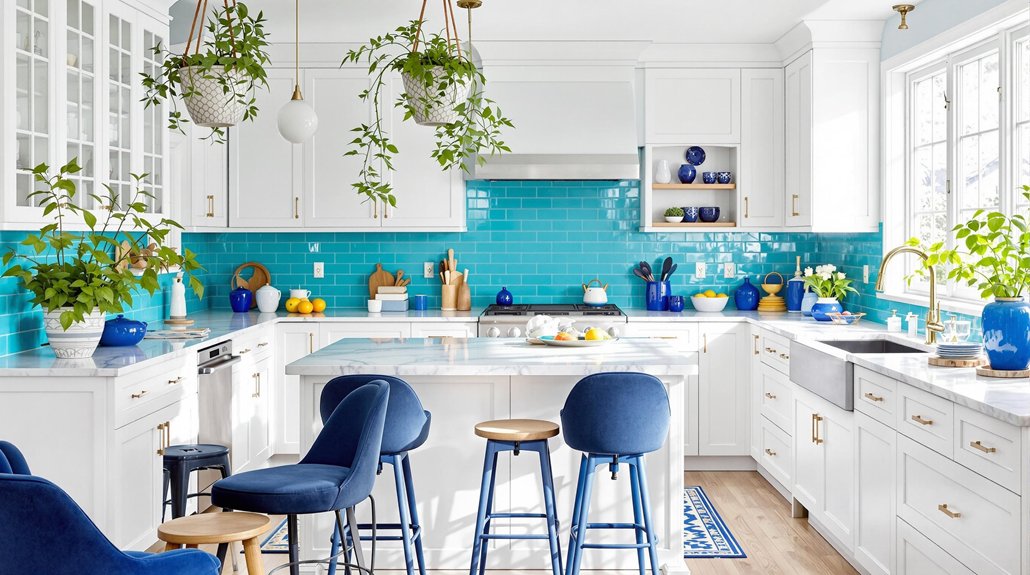
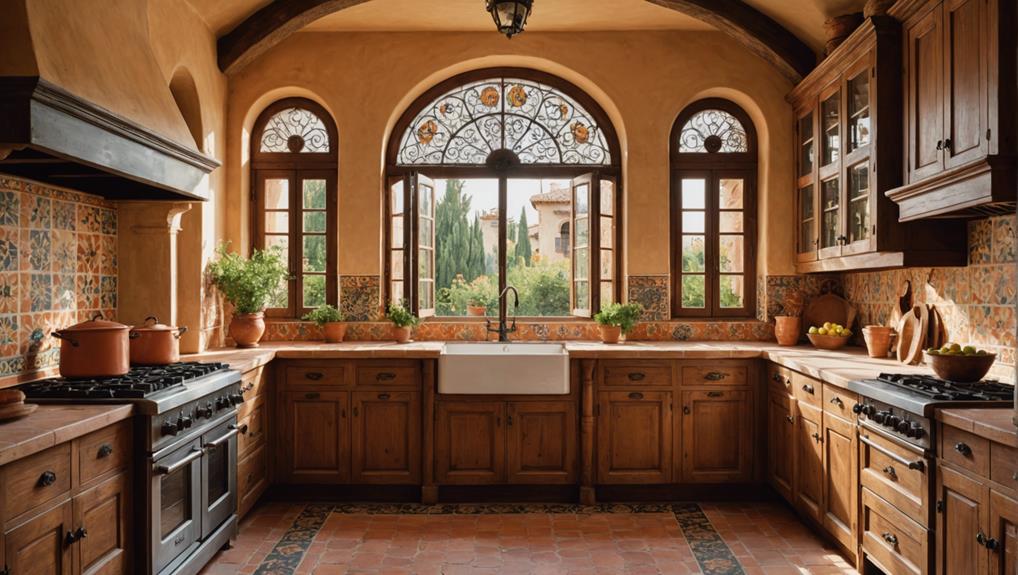
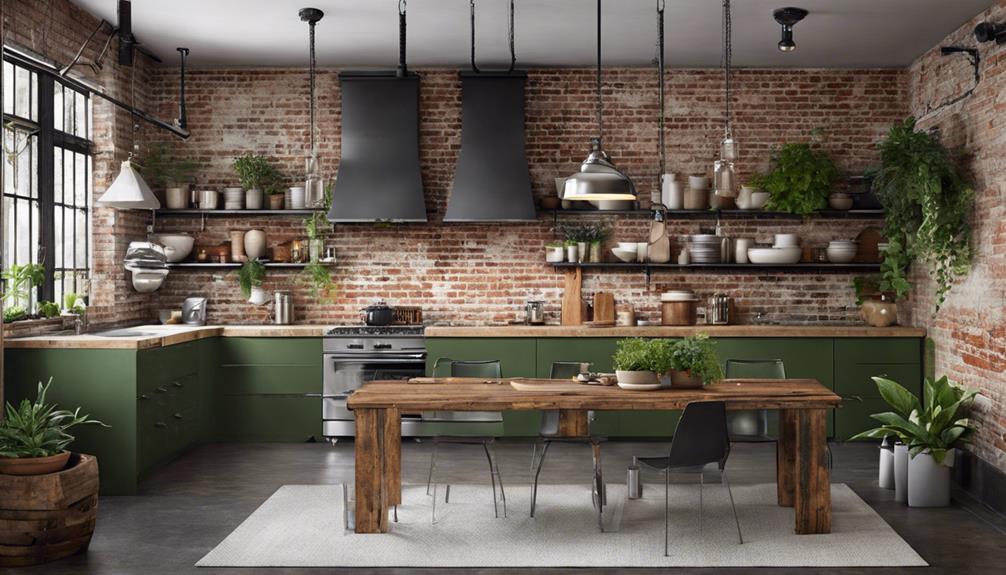
Leave a Reply